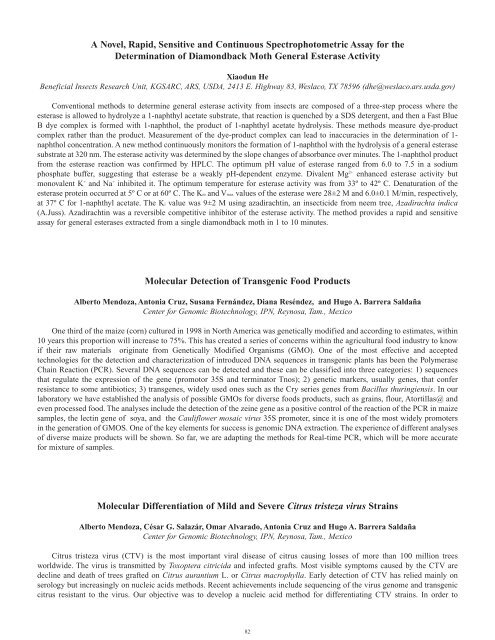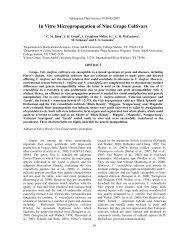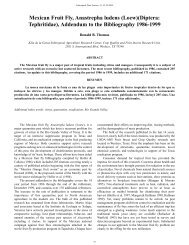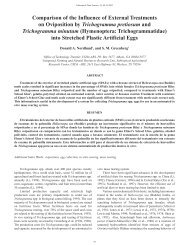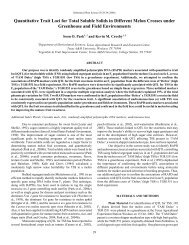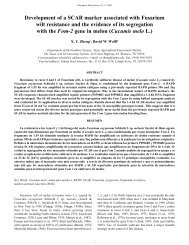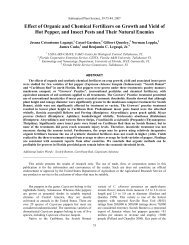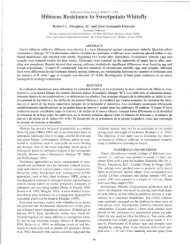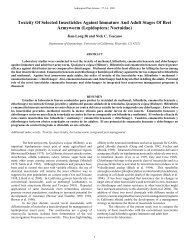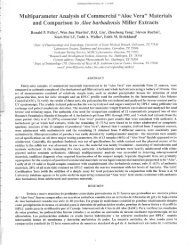Abstracts - Subtropical Plant Science Society
Abstracts - Subtropical Plant Science Society
Abstracts - Subtropical Plant Science Society
You also want an ePaper? Increase the reach of your titles
YUMPU automatically turns print PDFs into web optimized ePapers that Google loves.
A Novel, Rapid, Sensitive and Continuous Spectrophotometric Assay for the<br />
Determination of Diamondback Moth General Esterase Activity<br />
Xiaodun He<br />
Beneficial Insects Research Unit, KGSARC, ARS, USDA, 2413 E. Highway 83, Weslaco, TX 78596 (dhe@weslaco.ars.usda.gov)<br />
Conventional methods to determine general esterase activity from insects are composed of a three-step process where the<br />
esterase is allowed to hydrolyze a 1-naphthyl acetate substrate, that reaction is quenched by a SDS detergent, and then a Fast Blue<br />
B dye complex is formed with 1-naphthol, the product of 1-naphthyl acetate hydrolysis. These methods measure dye-product<br />
complex rather than the product. Measurement of the dye-product complex can lead to inaccuracies in the determination of 1-<br />
naphthol concentration. A new method continuously monitors the formation of 1-naphthol with the hydrolysis of a general esterase<br />
substrate at 320 nm. The esterase activity was determined by the slope changes of absorbance over minutes. The 1-naphthol product<br />
from the esterase reaction was confirmed by HPLC. The optimum pH value of esterase ranged from 6.0 to 7.5 in a sodium<br />
phosphate buffer, suggesting that esterase be a weakly pH-dependent enzyme. Divalent Mg 2+ enhanced esterase activity but<br />
monovalent K + and Na + inhibited it. The optimum temperature for esterase activity was from 33º to 42º C. Denaturation of the<br />
esterase protein occurred at 5º C or at 60º C. The Km and Vmax values of the esterase were 28±2 M and 6.0±0.1 M/min, respectively,<br />
at 37º C for 1-naphthyl acetate. The Ki value was 9±2 M using azadirachtin, an insecticide from neem tree, Azadirachta indica<br />
(A.Juss). Azadirachtin was a reversible competitive inhibitor of the esterase activity. The method provides a rapid and sensitive<br />
assay for general esterases extracted from a single diamondback moth in 1 to 10 minutes.<br />
Molecular Detection of Transgenic Food Products<br />
Alberto Mendoza, Antonia Cruz, Susana Fernández, Diana Reséndez, and Hugo A. Barrera Saldaña<br />
Center for Genomic Biotechnology, IPN, Reynosa, Tam., Mexico<br />
One third of the maize (corn) cultured in 1998 in North America was genetically modified and according to estimates, within<br />
10 years this proportion will increase to 75%. This has created a series of concerns within the agricultural food industry to know<br />
if their raw materials originate from Genetically Modified Organisms (GMO). One of the most effective and accepted<br />
technologies for the detection and characterization of introduced DNA sequences in transgenic plants has been the Polymerase<br />
Chain Reaction (PCR). Several DNA sequences can be detected and these can be classified into three categories: 1) sequences<br />
that regulate the expression of the gene (promotor 35S and terminator Tnos); 2) genetic markers, usually genes, that confer<br />
resistance to some antibiotics; 3) transgenes, widely used ones such as the Cry series genes from Bacillus thuringiensis. In our<br />
laboratory we have established the analysis of possible GMOs for diverse foods products, such as grains, flour, Atortillas@ and<br />
even processed food. The analyses include the detection of the zeine gene as a positive control of the reaction of the PCR in maize<br />
samples, the lectin gene of soya, and the Cauliflower mosaic virus 35S promoter, since it is one of the most widely promoters<br />
in the generation of GMOS. One of the key elements for success is genomic DNA extraction. The experience of different analyses<br />
of diverse maize products will be shown. So far, we are adapting the methods for Real-time PCR, which will be more accurate<br />
for mixture of samples.<br />
Molecular Differentiation of Mild and Severe Citrus tristeza virus Strains<br />
Alberto Mendoza, César G. Salazár, Omar Alvarado, Antonia Cruz and Hugo A. Barrera Saldaña<br />
Center for Genomic Biotechnology, IPN, Reynosa, Tam., Mexico<br />
Citrus tristeza virus (CTV) is the most important viral disease of citrus causing losses of more than 100 million trees<br />
worldwide. The virus is transmitted by Toxoptera citricida and infected grafts. Most visible symptoms caused by the CTV are<br />
decline and death of trees grafted on Citrus aurantium L. or Citrus macrophylla. Early detection of CTV has relied mainly on<br />
serology but increasingly on nucleic acids methods. Recent achievements include sequencing of the virus genome and transgenic<br />
citrus resistant to the virus. Our objective was to develop a nucleic acid method for differentiating CTV strains. In order to<br />
82


